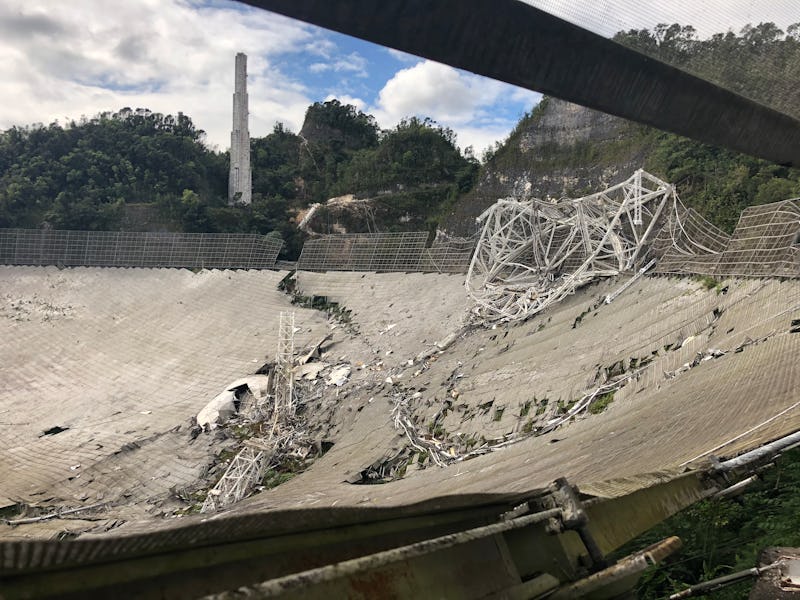The most iconic radio telescope ever is gone for good, U.S. government declares
Since then, many have called for the telescope to be rebuilt or for building an even better replacement telescope at the site.

The National Science Foundation announced last week that it won’t rebuild or replace the iconic Arecibo Observatory in Puerto Rico, which collapsed in 2020. Instead, the NSF says they have solicited calls for proposals to build a multidisciplinary educational center at the site.
Additionally, the plans do not appear to allow for any future science or observation from the other facilities at the Arecibo site, as the NSF said they will not provide any “operational support for current scientific infrastructure, such as the 12-meter radio telescope or Lidar facility,” also on location.
The announcement has been met with disappointment and disbelief.
“I am heartbroken by this decision,” said native Puerto Rican and planetary astronomer Edgard Rivera-Valentín, who was born in Arecibo and was inspired by the science and discoveries being made right in their backyard.
“Arecibo’s role in inspiring generations of Puerto Ricans centered on the fact that we had a world-class facility doing cutting-edge science in our home,” Rivera-Valentín told Universe Today. “When I had the privilege of working at the observatory, as the first Arecibeño scientist to do so, I saw how it continued to serve that important role. But it did so because we were doing great science with the telescope. It did so because scientists at the observatory could be mentors and role models to students. Without the telescope, without the scientists, I don’t personally see how going to the visitor center won’t be like going to a memorial.”
An overhead view of the damaged Arecibo Observatory after some cleanup
The collapse of Arecibo’s radio telescope was a devastating blow to the radio astronomy community. Issues began in 2017 for the nearly 55-year-old telescope when Hurricane Maria tore through Puerto Rico, shearing off one of the 29-meter (96-foot) antennas that was suspended above the telescope’s 305-meter (1,000-foot) dish, with falling debris puncturing the dish in several places.
In early 2020, earthquakes temporarily closed the observatory for safety reasons; then a succession of cable failures ultimately led to the December 2020 collapse of the 900-ton instrument platform suspended above the observatory, which crashed down on the iconic telescope’s giant dish. This collapse officially ended any possible hopes of refurbishing the famous observatory.
Since then, many have called for the telescope to be rebuilt or for building an even better replacement telescope at the site. Instead, the NSF wants Arecibo to serve as a hub for STEM education and outreach.
The NSF says that it is following community recommendations for not planning to rebuild the Arecibo Observatory. However, the most recent Planetary Science and Astrobiology Decadal Survey noted that, “The loss of the Arecibo Observatory planetary radar greatly inhibits the ability to perform follow-up NEO (near-Earth object) characterization. Existing radar infrastructure can observe only half the asteroids once observable with Arecibo.”
Rivera-Valentín, a planetary scientist whose work includes radar characterization of NEOs, said, “I am dismayed by the decision not to reconstruct the Arecibo telescope, especially without an alternate plan to replace or exceed the now lost capabilities of Arecibo.”
The Arecibo Observatory during its heyday.
The Arecibo Observatory was completed in 1963 and for over 50 years (until China’s Five-hundred-meter Aperture Spherical Telescope (FAST) was completed in 2016) it was the world’s largest single-aperture telescope. It was used in three major areas of research: radio astronomy, atmospheric science, and radar astronomy. The observatory has appeared in movies, television shows, and more, and is listed on the US National Register of Historic Places.
The facility has contributed to significant breakthroughs in astronomy and cosmology, including the discovery of the first binary pulsar, the first-millisecond pulsar, and the first exoplanets, along with helping to study asteroids and planets in the Solar System. In addition, the facility has also played an important role in the Search for Extraterrestrial Intelligence (SETI), providing the source data for SETI@home and the SETI Institute’s Project Phoenix.
While the decision not to rebuild affects the ability of scientists to study numerous astronomical objects, this decision will also affect Puerto Ricans. The NSF noted that the observatory had become “a highly regarded part of the community for many of Puerto Rico’s citizens, serving as a source of pride and local economic benefit while also providing access to training and employment for many in the community.”
Rivera-Valentín worries that because Puerto Rico does not have many on-island opportunities for STEM professionals, it will be difficult to retain island-born scientists and engineers.
“This will contribute to the ongoing so-called brain drain, which is seeing many people leaving the island for job opportunities,” Rivera-Valentín said. “The Arecibo Observatory was able to retain some of that important STEM expertise on the island by employing scientists and engineers. In regards to astronomy, Puerto Rico does not have many opportunities. This is best seen in the university system. Even as recent as a decade ago, Puerto Rico did not offer any degrees in astronomy. But because of the work the observatory scientists have done in engaging the local community, there are now Astronomy degrees offered by the University of Puerto Rico.”
Without an active scientific facility, Rivera-Valentín sees the potential for the momentum behind these efforts being greatly hindered.
“I hope I’m wrong,” Rivera-Valentín said.
You can read the NSF’s latest report on Arecibo here.
This article was originally published on Universe Today by Nancy Atkinson. Read the original article here.